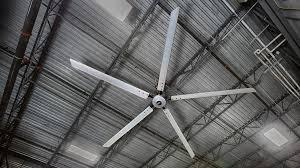When it comes to maintaining comfortable and energy-efficient environments in large facilities, HVLS (High Volume, Low Speed) industrial ceiling fans have become an essential solution. These fans are designed to move massive amounts of air at low speeds, improving airflow and reducing energy costs. However, choosing the right HVLS fan requires careful consideration of several factors. Here’s a detailed guide to help you make an informed decision for your building.
1. Understand Your Space Requirements
Before choosing an HVLS fan, start by analyzing your facility’s size, layout, and purpose. The ceiling height, floor area, and obstructions like beams or equipment all play a crucial role in determining the ideal fan size and placement. For instance, a warehouse with high ceilings and wide open areas may benefit from a larger fan with a wider blade span, while a manufacturing plant with machinery might require multiple smaller fans for balanced airflow.
2. Choose the Appropriate Fan Size
HVLS fans typically range from 8 to 24 feet in diameter, and selecting the right size is key to achieving optimal air circulation.
-
Small to medium areas (up to 10,000 sq. ft.): Consider fans between 8 to 14 feet.
-
Large open spaces (10,000–30,000 sq. ft.): Fans from 16 to 20 feet are ideal.
-
Massive facilities (over 30,000 sq. ft.): 22–24-foot fans can efficiently circulate air.
Selecting a fan that matches your space ensures even air movement without creating excessive airflow or noise.
3. Evaluate Airflow and Efficiency
The performance of an HVLS fan is measured by CFM (Cubic Feet per Minute)—the amount of air it moves per minute. A higher CFM indicates greater airflow and better air distribution. Look for fans that balance performance with energy efficiency, reducing your HVAC load and saving on energy bills. Models equipped with energy-efficient motors and optimized blade designs can deliver high performance with lower power consumption.
4. Consider Ceiling Height and Mounting Options
Ceiling height is one of the most critical factors in fan selection. HVLS fans generally require at least 20 feet of clearance from the floor to the ceiling for maximum effectiveness. Ensure the fan is installed at least 10 to 15 feet above the ground and at least 2 feet below the ceiling for ideal airflow. Depending on your building’s structure, you may need specific mounting accessories such as extension tubes or safety cables to ensure proper installation.
5. Material and Build Quality
Industrial fans operate in demanding environments, so durability is vital. Choose fans made from high-grade aluminum or steel with corrosion-resistant coatings, especially if your facility experiences humidity or chemical exposure. Additionally, fans with aerodynamically designed blades improve airflow while reducing drag and noise levels, ensuring both comfort and longevity.
6. Control Options and Smart Features
Modern HVLS fans come with advanced control systems that allow you to adjust speed, direction, and scheduling with ease. Many models now include smart integration capabilities, enabling remote operation via mobile apps or building management systems (BMS). Look for features such as automatic temperature adjustments and synchronization with HVAC systems for enhanced energy efficiency.
7. Safety and Compliance
Safety should never be overlooked. Verify that your chosen HVLS fan meets industry safety standards such as UL, CE, or AMCA certifications. Fans equipped with redundant safety systems—like hub-to-blade safety cables and impact-resistant designs—minimize risks in case of mechanical failure. Always ensure professional installation for proper balancing and secure mounting.
8. Budget and Long-Term Value
While HVLS fans require an upfront investment, their long-term savings in energy and maintenance make them a cost-effective solution. Compare different brands and models not only on price but also on energy savings, warranty coverage, and lifespan. A slightly higher initial cost may offer better performance and durability over time.
9. Manufacturer Support and Warranty
Select a reputable manufacturer with proven experience in the industry. Companies that provide installation support, maintenance services, and extended warranties offer better value and peace of mind. Reliable customer support ensures your fan operates efficiently throughout its lifespan.
Conclusion
Choosing the right HVLS industrial ceiling fan for your building can dramatically improve air circulation, reduce energy costs, and create a comfortable environment for employees and equipment alike. By considering factors such as size, efficiency, safety, and smart control options, you can make a well-informed decision that benefits your facility for years to come.



